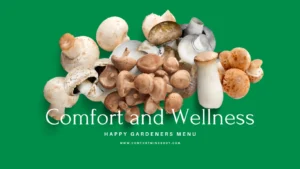Mushrooms
Mushrooms are a delicious and nutritious addition to any meal. They are low in calories, high in fiber and protein, and packed with vitamins and minerals. While most people buy mushrooms from the grocery store, growing your own mushrooms at home can be a fun and rewarding experience. In this beginner’s guide, you will learn everything you need to know about growing mushrooms at home, from the benefits of growing your own mushrooms to the different methods of growing mushrooms.
Benefits:
Growing your own mushrooms has several benefits. First, you can enjoy fresh and flavorful mushrooms that are free from pesticides and other harmful chemicals. Second, growing your own mushrooms can save you money in the long run, as store-bought mushrooms can be expensive. Third, growing mushrooms at home is a fun and engaging hobby that can help you connect with nature.
Types of Mushrooms to Grow at Home
There are several types of mushrooms that you can grow at home, including button mushrooms, oyster mushrooms, shiitake mushrooms, and more. Each type of mushroom has its own unique flavor and texture, so it’s important to choose a variety that you enjoy eating. Button mushrooms are the most common type of mushroom and are relatively easy to grow, making them a good choice for beginners.
Understanding the Mushroom Growing Process
Mushrooms grow from mycelium, which are the underground threads that form the body of the mushroom. To grow mushrooms at home, you will need to purchase mushroom spores or spawn, which are essentially the seeds of the mushroom.
The spores or spawn are then added to a substrate, which is the material that the mycelium will grow on. Once the mycelium has fully colonized the substrate, it will start producing mushrooms.
Materials Needed for Growing Mushrooms
To grow mushrooms at home, you will need a few basic materials. These include a container or bag for the substrate, mushroom spores or spawn, a sterilized growing medium, such as sawdust or straw, and a humidifier or spray bottle to maintain proper humidity levels. You may also need a thermometer and hygrometer to monitor the temperature and humidity of your growing environment.
Creating a Suitable Environment for Growing Mushrooms
Mushrooms require a specific environment in order to grow properly. They need a warm and humid environment with plenty of fresh air and indirect sunlight. The ideal temperature for growing mushrooms is between 60 and 80 degrees Fahrenheit, depending on the variety of mushrooms. You will also need to maintain a humidity level of around 80-90% by misting the growing medium regularly.
The Different Methods
There are several methods of growing mushrooms at home, including growing mushrooms in containers, bags, or logs. Growing mushrooms in containers or bags is the most common method, as it is relatively easy and requires minimal space. To grow mushrooms in containers or bags, you will need to add the substrate and mushroom spores or spawn, and then cover the container or bag to maintain humidity.
Caring for Your Mushrooms
Growing mushrooms requires regular care and maintenance. You will need to monitor the temperature and humidity of your growing environment, mist the growing medium to maintain humidity levels, and check the substrate for signs of contamination. You may also need to adjust the pH level of the growing medium to ensure optimal growth.
Harvesting and Storing Your Mushrooms
Once your mushrooms have fully matured, it’s time to harvest them. To harvest mushrooms, gently twist or cut them at the base of the stem. Be sure to harvest your mushrooms before the caps start to open, as this can reduce the flavor and texture of the mushroom. Store your mushrooms in a paper bag in the refrigerator for up to a week.
Common Problems
Growing mushrooms at home can be challenging, and there are several common problems that you may encounter. These include contamination, mold, and low yields. To prevent contamination, be sure to use sterilized equipment and maintain a clean growing environment. To prevent mold, be sure to maintain proper humidity levels and avoid overwatering. To increase yields, you may need to adjust the temperature, humidity, or pH level of your growing environment.
Mushroom Farming: Taking it to the Next Level
If you enjoy growing mushrooms at home and want to take it to the next level, you may want to consider mushroom farming. Mushroom farming involves growing mushrooms on a larger scale for commercial purposes. To start a mushroom farm, you will need to invest in equipment and supplies, such as a growing room, ventilation system, and growing medium. You will also need to obtain permits and licenses to operate a commercial mushroom farm.
Learn how to grow. Happy gardeners menu! Imagine you knew how to grow healthy and pesticide-free mushrooms in a way that people would swear you purchased them from organic farmers. The product below promises to reveal all the secrets of organic mushroom cultivation, no matter your starting level or whether you have no clue about it at all.
Therefore, it can be your personal gardening and family, on the other hand, you can turn it into a business. It’s your choice.
Conclusion
Growing mushrooms at home can be a fun and rewarding experience. With the right materials, environment, and care, you can enjoy fresh and delicious mushrooms year-round. Whether you are a beginner or an experienced grower, there is always something new to learn about growing mushrooms. So why not give it a try and start growing your own mushrooms today?
Ready to start growing your own mushrooms at home? Purchase high-quality mushroom spores and supplies from our online store and begin your mushroom-growing journey today!
Affiliate Disclosure:
The links contained in this product review may result in a small commission. This goes towards supporting our research and editorial team and please know we only recommend high-quality products.
Note: This article is for informational purposes only and is not intended to diagnose, treat, or cure any disease. Always consult a healthcare professional before taking any supplement or making any changes to your diet or lifestyle.






